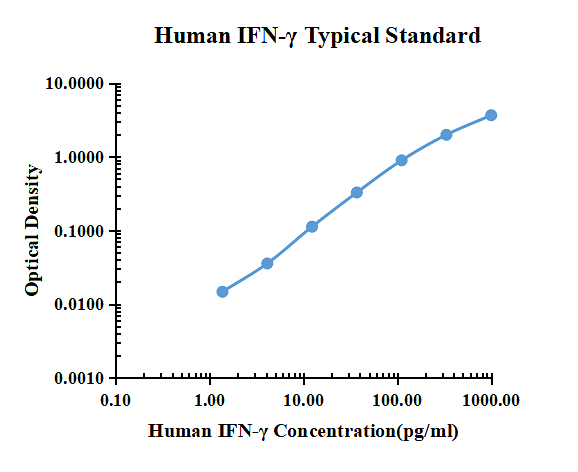Human IFN-gamma enzyme-linked immunoassay kit
| Specification | 96 Test |
|---|---|
| Sensitivity | 0.36 pg/ml (50 μl);0.85 pg/ml (10 μl) |
| Standard Curve Range | 1.37~1000 pg/ml |
| Standard Curve Gradient | 7 Points/3 Folds |
| Number of Incubations | 2 |
| Detectable sample | Liquid phase sample of soluble substances. For example: serum, plasma, cell culture supernatant, tissue grinding liquid, etc. |
| Sample Volume | 50 μl/10 μl |
| Type | Fully Ready-to-Use |
| Operation Duration | 75min |

| pg/ml | O.D. | Average | Corrected | |
|---|---|---|---|---|
| 0.00 | 0.0117 | 0.0121 | 0.0119 | |
| 1.37 | 0.0250 | 0.0282 | 0.0266 | 0.0147 |
| 4.12 | 0.0462 | 0.0489 | 0.0476 | 0.0357 |
| 12.35 | 0.1248 | 0.1240 | 0.1244 | 0.1125 |
| 37.04 | 0.3399 | 0.3393 | 0.3396 | 0.3277 |
| 111.11 | 0.9201 | 0.8954 | 0.9078 | 0.8959 |
| 333.33 | 2.0160 | 1.9910 | 2.0035 | 1.9916 |
| 1000.00 | 3.6940 | 3.6730 | 3.6835 | 3.6716 |
Precision
| Intra-assay Precision | Inter-assay Precision | |||||
| Sample Number | S1 | S2 | S3 | S1 | S2 | S3 |
| 22 | 22 | 22 | 6 | 6 | 6 | |
| Average(pg/ml) | 17.2 | 98.2 | 273.3 | 18.9 | 91.8 | 240.1 |
| Standard Deviation | 0.5 | 3 | 6.8 | 0.8 | 2.7 | 5.2 |
| Coefficient of Variation(%) | 2.8 | 3.2 | 2.5 | 4.2 | 3 | 2.1 |
Intra-assay Precision (Precision within an assay) Three samples of known concentration were tested twenty times on one plate to assess intra-assay precision.
Inter-assay Precision (Precision between assays) Three samples of known concentration were tested six times on one plate to assess intra-assay precision.
Spike Recovery
The spike recovery was evaluated by spiking 3 levels of human IFN gamma into health human serum sample. The un-spiked serum was used as blank in this experiment.
The recovery ranged from 89% to 113% with an overall mean recovery of 105%
Sample Values
| Sample Matrix | Sample Evaluated | Range (pg/ml) | Detectable (%) | Mean of Detectable (pg/ml) |
|---|---|---|---|---|
| Serum | 30 | n.d.-446.28 | 92 | 93.56 |
Serum/Plasma – Thirty samples from apparently healthy volunteers were evaluated for the presence of IFN-gamma in this assay. No medical histories were available for the donors.
n.d. = non-detectable. Samples measured below the sensitivity are considered to be non-detectable.
Product Data Sheet
Background: IFN-gamma
Interferon-gamma (IFN-gamma), also known as type II or immune interferon, exerts a wide range of immunoregulatory activities and is considered to be the prototype proinflammatory cytokine. Mature human IFN-gamma exists as a non-covalently linked homodimer of 20-25 kDa variably glycosylated subunits. It shares 90% amino acid (aa) sequence identity with rhesus IFN-gamma, 59%‑64% with bovine, canine, equine, feline, and porcine IFN‑ gamma, and 37%‑43% with cotton rat, mouse, and rat IFN-gamma. IFN-gamma dimers bind to IFN-gamma RI (alpha subunits) which then interact with IFN-gamma RII (beta subunits) to form the functional receptor complex of two alpha and two beta subunits. Inclusion of IFN-gamma RII increases the binding affinity for ligand and the efficiency of signal transduction. IFN-gamma is produced by a variety of immune cells under inflammatory conditions, notably by T cells and NK cells. It plays a key role in host defense by promoting the development and activation of Th1 cells, chemoattraction and activation of monocytes and macrophages, up‑regulation of antigen presentation molecules, and immunoglobulin class switching in B cells. It also exhibits antiviral, antiproliferative, and apoptotic effects. In addition, IFN-gamma functions as an anti-inflammatory mediator by promoting the development of regulatory T cells and inhibiting Th17 cell differentiation. The pleiotropic effects of IFN-gamma contribute to the development of multiple aspects of atherosclerosis.

